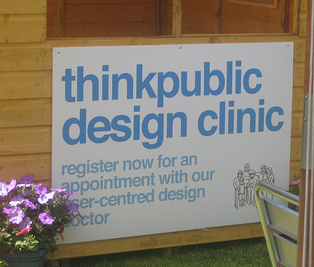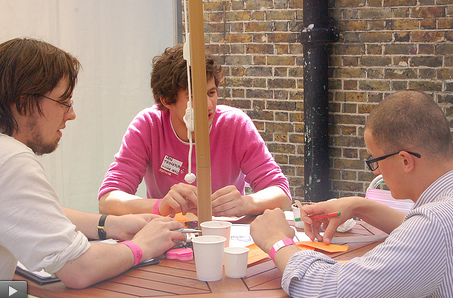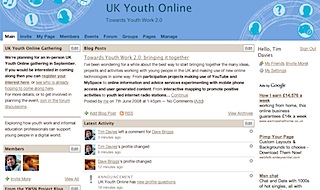I was recently asked to write an article for Children and Young People Now on ‘Youth Work in a Digital Age’. The resulting article was published in last weeks issue (15th – 21st October 09) and you can find it on the Children and Young People Now website here.
I’m grateful to C&YPN Editor Andy Hillier for his patience with my tendency to overshoot all word limits in a first draft, and for helping to turn my original drafts into a practical piece for a print magazine.
But, with the luxury of a blog, where running to 1967 words, rather than the allotted 1500 for a spread in C&YPN, I though I would take the liberty of posting here an earlier draft, which takes a bit more a theoretical look at the question of Youth Work in a Digital Age. All comments and feedback welcome…
Youth Work in a Digital Age (v 0.1)
Where can you always find a group of young people hanging out together; chatting about everyday life and about issues that matter; planning an upcoming adventure; reflecting upon all the activities they have recently been involved in; sharing jokes; flirting with one another; having heart-to-heart discussions with their peers; and generally being young people? Ten years ago ‘the youth club’, or ‘the street corner’ might have been the answer. Today it’s far more likely to be online – on Bebo.com or MSN Messenger.
Some people have seen this as a threat to youth work as we know it – but if you had been listening in at the ‘Young people and youth work in a digital age’ conference that took place at Glyndwr University last month, you would have been far more likely to hear youth workers talking about the golden opportunities that digital technologies have created for practitioners to promote activities; to engage with young people; and to generally deliver high quality youth work.
With over 80% of young people using one or more social network sites (5 in 6 young people aged 11 – 25 were users of at least one social network site in a April 2009 representative sample study of 1000 young people by nfpSynergy) and young people increasingly turning to the internet for communication, entertainment and information youth work cannot afford to miss the digital boat.
Made for youth work?
Over recent years young people’s use of digital media has shifted from consuming entertainment and information, to creating and sharing content, being in constant communication with peers, and participating in online communities. With the right support from informal educators, digital media offers the tools and platforms for young people to move from ‘consumer’ to ‘creator’.
Working with young people online, where many of the power dynamics between young people and adults are turned on their head, can, as many workers have discovered, create an environment far closer to the youth work ideal of voluntary engagement. Youth worker Katie Bacon, who has been using the web to engage diverse groups from across Devon in decision making explains: “Online young people are often far more honest and up-front with their opinions, and the presence of the ‘block’ button that young people can use to end a conversation puts them far more in control. It can be challenging and disconcerting for workers, but once you get used to it you can see that it’s voluntary engagement in practice.”
And with social network sites very much based around peer-group interaction and relationship building, it is easy to see the potential fit between digital media and core youth work values and practices.
Even so, digital media tools have rarely been created with a ‘youth workers instruction manual’ to accompany them – so the challenge for youth workers is to work out how to understand, adopt and adapt digital media tools for their practice. It can help to think about three forms of ‘youth work in a digital age’: (1) supporting young people to navigate growing up in a digital world; (2) using digital media tools to promote and add value to existing youth work; (3) weaving the digital media tools into youth work activities – and making the most of the technology for youth work goals.
Growing up digital
Just ten years ago, young people may have only been able to be in social contact with their peers for a small part of the day: snatched conversations between lessons at school, on the way home, or meeting up for a few hours in the evening. A couple of hours spent in a youth project may have been a significant part of young people’s social time. Now, many young people live in near constant contact with peers, sharing text messages, photos and videos from phones, computers and consoles. In this world where communication moves faster, both positive and negative experiences can be ‘amplified’ by digital media; and the divide between those with access and skills to be connected, and those without can widen.
Whilst government backed education programmes such as ThinkUKnow.co.uk are doing important work educating professionals and young people about potential dangers of digital media, youth workers have an additional role in equipping young people not only with awareness of the risk, but also with the resolve, resources and resiliency to navigate dangers, whilst still taking advantage of online opportunities.
That might involve giving a peer group the opportunity to reflect upon the sorts of images, photos and videos of themselves and their friends they are sharing online – and to come to an agreement about what to share or what not to. Or it might involve workers being attuned to instances when bullying might be moving onto the web, and being ready to address the underlying bullying. Starting from young people’s experience of digital media, youth workers need to be supporting young people to become digital media literate, and for many workers that will start with developing their own digital media literacy.
Promote what you do
You can support young people to develop skills and literacy for growing up digital without touching any technology yourself, but if you want to reach out and promote youth work activities to young people for whom the internet is the primary information source then it’s time to log-on. Setting up a blog, for example, gives you an instant (and free) publishing platform where you can share news about your project and details of upcoming events – and within weeks details of what you do should be appearing in search engine results, helping young people discover and remind themselves of what you do.
Facebook Pages, or Bebo and MySpace profiles, can provide a powerful free platform for promoting projects and activities to young people – taking the message to the social network spaces where young people are hanging out. When Denise Drake updates the Tower Hamlets Summer University Facebook Page, the update is featured in the news feeds of over 250 people, all of whom have signed up as ‘Fans’ of Summer Uni. If any of those people comment on one of these updates, then their comment (and the original message) could also be shown in the news feeds of their friend networks on Facebook. News of new activities can spread quickly through the network.
Of course, one of the greatest potentials of digital media is the ability to show young people what’s on offer, rather than just telling them in text. With cheap video hosting and online editing tools – sharing videos, photos or recordings to give young people an insight into what happens at your project is easier than ever.
However, if you try promotion without participation you’re likely to be disappointed. As local authority communications expert Simon Wakeman recently explained in an interview on the Plings project blog (http://blogs.plings.net): “It’s two-way communication – having a one-way dialogue just doesn’t work! Social media blends communications and consultation. You can’t start using social media without being prepared to have conversations online.
Weaving digital media in
Digital media can be a big draw to attract young people to take part in a project. But more importantly, ensuring young people have digital skills is key to support both their participation in social life and education now, and in social life, education and work in the future.
For just about any youth work activity there will be digital media tool that can add a new dimension to it: from using online video clips as discussion starters at a youth club, to using blogging to help young people reflect upon and document an international youth exchange. And as Hilary Mason, Senior Manager at West Sussex youth service recently discovered, when using blogging as a way for young people on exchanges to China and India to reflect on their experiences and share news with friends and family back home – there are often unexpected positive impacts of using digital media: “There was a knock-on effect in the local community – with parents and grandparents who would normally not be using a computer reading and commenting on the blogs. The messages of affirmation to young people coming from family back home with written comments saying ‘I love you’ or ‘I miss you’ were very powerful.”
In weaving digital media tools into youth work practice there are often decisions to be made about what is published on the web, and how you manage conversations and communication. In the case of young people blogging from China, West Sussex youth service made sure that there were staff back in the UK to check over blog posts before they went on the web, and to address and issues that came up. “One of the main things that came up was comments from parents – we had to remind them that the blog was public communication.”
Getting started
If you’re not already using digital media in your work, then knowing where to start can be tricky. But, as the Youth Work and Social Neworking report (NYA, 2008) sets out – there are four simple steps to going digital.
1) Survey: find out what’s already going on in your organisation & find out about the digital opportunities young people are interested in. Create a ‘community profile’ of the social media spaces young people are active in (there’s no point being on Facebook if everyone you work with in on Bebo). Check what policies your organisation has on digital media, and check what technology you have available.
2) Strategy: choose how you will engage with digital media. Will you discuss digital media issues with young people but without using the technology directly? Will you use digital media as a promotion tool? In face-to-face settings? Or as a tool for online outreach?
3) Safety: check out the safety issues linked with your choice of digital media. Think about possible safety issues and how to overcome them. Most issues can be overcome with careful thought. You can find an overview of key safety issues to consider in the online Youth Engagement & Social Media guide that I’ve been developing here: http://is.gd/3Orsc
4) Skills: give yourself an hour or two to explore the digital media tools you are planning on using. Try them out – or find a colleague who can teach you how to use them. You don’t need to be an expert – just confident enough to learn as you go along, and to identify the issues that may make for discussion points with young people.
Going further
Finding your own route to engage with digital media in youth work can seem daunting, particularly when there is no set pattern to copy. However, digital media isn’t just about youth work delivery. It can also play a part in youth worker’s professional development and learning – and you will find a growing range of supportive online communities, reflective blogs, and online resources to help you explore youth work in a digital age.
Often, starting to use the tools for your own professional development, whether reading and commenting on blog posts from other youth workers, or participating in a focussed network of youth work practitioners such as YouthWorkOnline.org.uk, you can pick up the skills and experiences you need to apply digital tools in your own practice. Hilary Mason was one of the first youth work bloggers from the statutory sector, and for Hilary being able to explore both digital tools and youth work ideas through maintaining a blog at http://ukyouthblog.wordpress.com/ is key: “As a reflective tool it’s huge, both in spending time writing and thinking about what you are going to say.”
The digital world is here. And it’s moving forward at a phenomenal pace. Youth work has some catching up to do – but it also has a key opportunity and offer to make – and hopefully soon we’ll be seeing all youth work as work engaged with the digital age.


 So – I though it might be time for another unConference. And this is the rather roundabout way of announcing: Connected Generation 2009 – unConference – exploring youth engagement in a digital age.
So – I though it might be time for another unConference. And this is the rather roundabout way of announcing: Connected Generation 2009 – unConference – exploring youth engagement in a digital age.


 I've just been interviewed for an article about how blogging can be used to promote positive activities. Using blogging as part of promoting youth work was only one part of one of the
I've just been interviewed for an article about how blogging can be used to promote positive activities. Using blogging as part of promoting youth work was only one part of one of the  I've tried to keep the plethora of reflections and shared bits and pieces from the Youth Work and Social Networking project over on
I've tried to keep the plethora of reflections and shared bits and pieces from the Youth Work and Social Networking project over on  I’m on the way home from two days of
I’m on the way home from two days of 
 I've been looking for a while for a space where all the conversations around work with young people and new technologies/social media/web 2.0 can come together.
I've been looking for a while for a space where all the conversations around work with young people and new technologies/social media/web 2.0 can come together.
 Just a quick pointer to the
Just a quick pointer to the  This is a post I've been wanting to put together for a while. Hopefully the phase 1 report from the
This is a post I've been wanting to put together for a while. Hopefully the phase 1 report from the